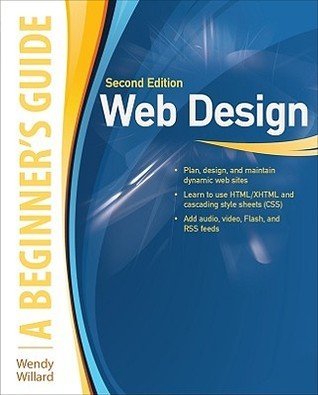Web Design: A Beginner's Guide Second Edition by Wendy Willard
My rating: 2 of 5 stars
This book is probably only useful if you're completely new to web design. The book itself isn't very educational, but it includes dozens of references to tools, sites, and services that are useful for learning web design. The most useful chapter for me was the first, which teaches how to discover client requirements and write documentation such as proposals, statements of work, and design specs.
The book provides an introductory overview of the phases of web design: planning and analysis, design, development, then transfer and maintenance. It familiarizes you with HTML, CSS, JavaScript, and multimedia, but refers you to other books and sites to learn the details.
Author Wendy Willard promotes designing standards compliant, accessible, usable websites. She recommends offering additional services besides web design, such as SEO and HTML email design. For email design, she recommends using campaignmonitor.com.
Below are the notes I took as I read.
Sites for learning web design
Recommended web hosts
Free HTML editors
Web design proposal
A proposal for a web design project should include the following sections. You can download a sample proposal from the author's site, WendyWillard.com.
- Purpose: restatement of client's business needs
- Scope/Statement of Work: details of work, including list of pages and features
- Design requirements gathering: example sites, text and graphics, demographics
- Web template design: site map, layout, color theme, number of edits
- Coding & development: pages, rounds of edits
- Project management: administrative tasks covered by project cost
- Conditions/Assumptions: conditions and assumptions that may affect cost and schedule
- file transfer method
- communication method and frequency
- testing (screen size, browsers, speeds)
- copyright ownership
- post-launch edits
- Hosting
- Cost
- Schedule
- Biographies: bios of design team members, stating experience and skills
Floating and positioning
- Floated content must appear in HTML above the content that must wrap around it.
- Relative positioning moves elements relative to their original location.
- Fixed positioning moves elements relative to the browser window.
- Absolute positioning moves elements relative to their parent element.
- Use z-index to layer elements that are relatively or absolutely positioned.
Testing designs of sites and HTML email
Test your site in multiple browsers using Adobe BrowserLab or BrowserShots.org. Test HTML email with Litmus.com.
SEO
- Put keywords in the URL, heading tags, body copy, images (alt attributes), links (title attributes), page titles, and meta tags (although meta tags are ignored by many engines).
- Search engines rank sites based on incoming links and user input.
- The fastest way to appear in search results is PPC (pay-per-click) advertising (sponsored links), such as Google AdWords.
Job applicant tracking services
You can integrate these services into your sites for tracking job applicants.
